IN THIS ISSUE
- Nature's night lights
- An avian work of art
- Tortoise homecoming at Altama
- Dive to survive: the killdeer way
- Royal predator targets crawdads
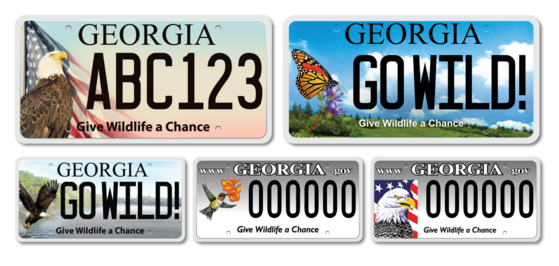 If you’re a Georgia vehicle owner with a birthday coming up, treat your ride and your wild neighbors by purchasing an eagle or monarch butterfly plate – or renewing one of these or the older eagle and hummingbird tag designs.
Either option works for wildlife. DNR’s nongame wildlife plates are the top fundraiser for making sure the wild animals, plants and places you treasure are here for generations to come.
As you celebrate another year, add a tag and do your part to drive Georgia wild!
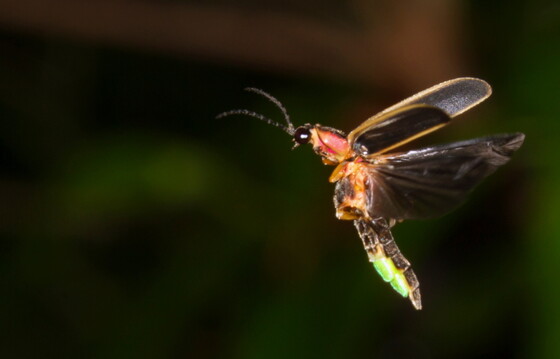 Common eastern, or big dipper, firefly (Adobe Stock)
By ETHAN HATCHETT
As late spring melts into summer, humid evenings host more insects than just mosquitos. At dusk, the flashes of fireflies appear in the haze of suburban yards and forest edges across Georgia, delighting children and adults.
Fireflies, or lightning bugs, are beetles adapted to be bioluminescent. But the light they emit from their abdomen is more than ornamental: It serves a variety of purposes. From the time a firefly egg is laid, light plays an important role in the insect’s life. Firefly eggs, larvae and pupa glow as a strategy to deter predators, while adults use bioluminescence to attract mates.
The firefly usually seen in Georgia is the big dipper, but the state is home to at least 40 species. Some flash in sync, others glow continuously and some even create spectacular shows with intermittent flashes and rings of light.
In 2021, a rare version of one of these latter lightning bugs was documented in Walton County. The loopy 5, named for its pattern of flashes, is found in only a few spots in Georgia, South Carolina and Tennessee. Because it’s so scarce and facing threats, this firefly has been petitioned for Endangered Species Act listing.
Read on to learn about loopy 5s, the Firefly Atlas and glowworm-friendly yards.
Ethan Hatchett is a communications assistant in DNR’s Wildlife Conservation Section
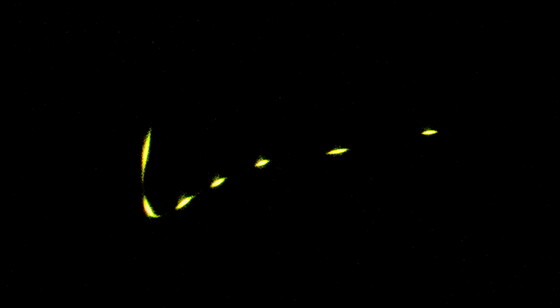 The display of a loopy 5 (Allen Grubbs/AWCG)
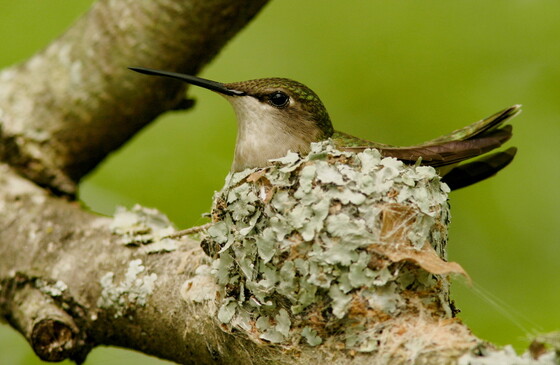 A ruby-throated hummer on her nest (Ty Ivey/GNPA)
By TERRY W. JOHNSON
The ruby-throated hummingbird’s nest is by far the most amazing nest built by any bird that breeds in Georgia. When you see one, it is difficult to imagine that a bird weighing little more than a penny can pull off what is truly a work of art.
All credit goes to the female ruby-throat: She builds the nest, lays and incubates the eggs, and feeds the hatchlings. In Georgia, ruby-throats nest twice a year, so adult females are doing this wearying task twice each breeding season.
Here’s a glimpse into how …
Terry W. Johnson is a retired DNR manager and executive director of TERN, friends group of the Wildlife Conservation Section. Check out past columns and his blog. Permission is required to reprint a column.
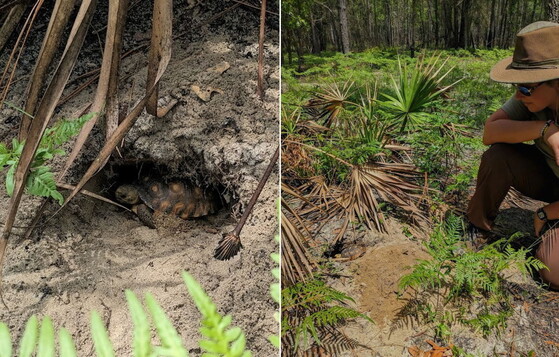 Fish and Wildlife's Jessica Radich releases a juvenile tortoise into a starter burrow at Altama. (James Hunt/DNR)
A homecoming for 17 juvie gopher tortoises at Altama Plantation highlighted work to restore wildlife habitat at the Brunswick wildlife management area and others along Georgia’s coast.
The tortoises came from nests laid at Altama’s native plant nursery. To boost their chances of surviving, Warm Springs National Fish Hatchery raised the torts – most of them from eggs – to about 4 inches long. DNR and U.S. Fish and Wildlife Service staff then dug starter burrows and released the youngins on a sandhill sporting some of the WMA’s best upland longleaf-pine wiregrass.
The release last month connected a lot of dots. To thrive, gopher tortoises need healthy groundcover (the layer of forest-floor plants). DNR is using prescribed fire and other management to boost groundcover at Altama. But the WMA’s nursery is also shaping up as a vital regional source of native plants and seeds.
That means more plants for restoration, more habitat for gopher tortoises and more tortoises for Georgia.
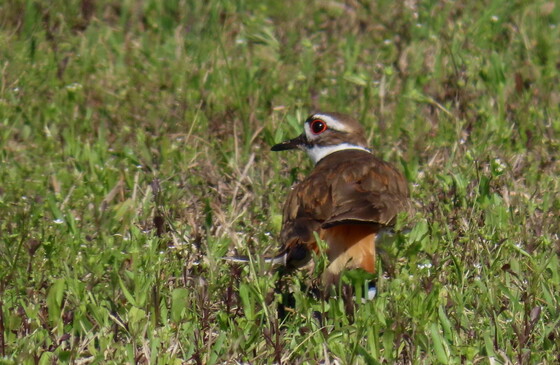 Nesting killdeer begins its performance (Bob Sargent/DNR)
When DNR pilot Ryan Buller and Program Manager Bob Sargent returned to Fulton County Airport after surveying eagle nests earlier this spring, Sargent noticed a brown patch in an apron of stones around a fuel tank.
A quick look with binoculars revealed that the patch was alive. It was a killdeer holding fast to its nest site despite the roar of the helicopter no more than 70 feet away.
That actually wasn’t surprising. Killdeer, a common plover species, often lay their eggs in gravel or stones on airfields and construction sites. They then devotedly incubate the well-camouflaged orbs as cars drive by, planes taxi past and helicopters take off and land nearby.
But what happened as Sargent slowly walked toward the nest was also not shocking. The killdeer eased into an award-winning performance designed to draw this perceived threat away from its nest.
Read more about the killdeer’s protective play-acting.
Related: Killdeer nesting on Valdosta soccer field. “This isn't exactly what we had in mind when we said ‘multipurpose field,'” quips Parks and Recreation agency.
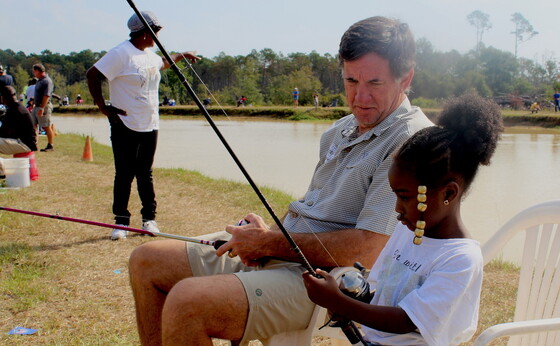 DNR Commissioner Mark Williams helps a young angler during a Kids Fishing Event (DNR)
In a job change that will keep him closer to home, Mark Williams is stepping down as DNR commissioner and starting work July 1 as executive director of the Jekyll Island Authority. Williams, a south Georgia native and Jesup resident, said a significant factor was spending more time with his family. “I love DNR with all my soul, but I love my family more,” he told the Board of Natural Resources during its latest meeting at DNR headquarters in Atlanta. Williams said leading the some 1,600-employee agency charged with managing and conserving Georgia’s natural, historic and cultural resources has been the “honor of my life.” Gov. Brian Kemp appointed him in 2010. In a statement to The Brunswick News, Kemp thanked Williams and said that under his guidance DNR “has made great strides in conserving the beautiful assets of our state and our shared natural heritage.”
See a wild turkey, tell DNR. The annual brood survey that provides a regional and statewide index of turkey reproduction runs from June through August, with participants documenting sightings of poults, hens and gobblers via this website.
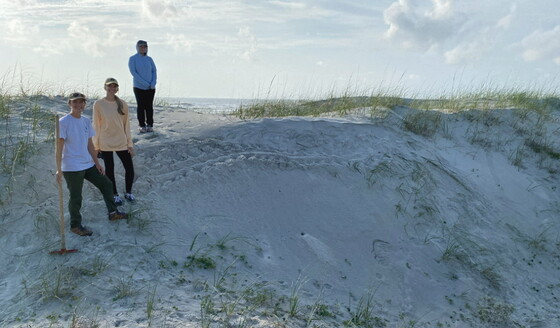 National Park Service turtle crew tracks the nesting loggerhead into secondary dunes (Mark Dodd/DNR)
While most sea turtles nest in the face of sand dunes along the beach, one ambitious mom on Cumberland Island crawled over those dunes and into the secondary ones to lay her eggs. Georgia Sea Turtle Program coordinator Mark Dodd, noting that Cumberland has the coast’s largest dune field, wrote, “I think we can safely assume this nest won’t be affected by tidal inundation.”
The list of senators cosponsoring the reintroduction of Recovering America’s Wildlife Act is growing. Backing for the bill to restore the nation’s wildlife varies from Republican Sen. Lindsey Graham of South Carolina to Democratic Sen. John Tester of Montana and independent Sen. Kyrsten Sinema of Arizona. Proposed Georgia projects. Related: "Snot otters and other wildlife aren’t rock stars; should they be saved?"
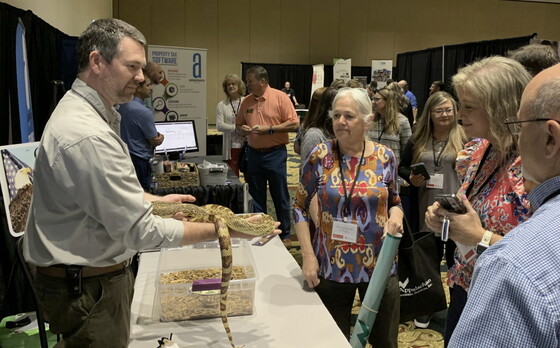 Charlie Elliott's Berkeley Boone shows a pine snake to GATO members in Athens (Rick Lavender/DNR)
Charlie Elliott Wildlife Center, one of six DNR education centers, was booked with outreach in May. Staff at the Mansfield center worked events from the Bluebirds and Bluegrass festival at Dauset Trails Nature Center in Jackson to the Hornyhead Fish Festival in Newborn and Great Outdoors Day on the Atlanta BeltLine, while also promoting wildlife license plates at the Georgia Association of Tax Officials conference in Athens.
DNR wildlife biologist Anna Yellin recently led a Georgia Audubon Urban Ecologists program on invertebrates, helping the group learn iNaturalist, coordinating an insect bioblitz and building mason bee boxes. The Urban Ecologists series, offered in Atlanta and Athens, involves eighth- through 12th-graders in a year-long exploration of the state’s ecology.
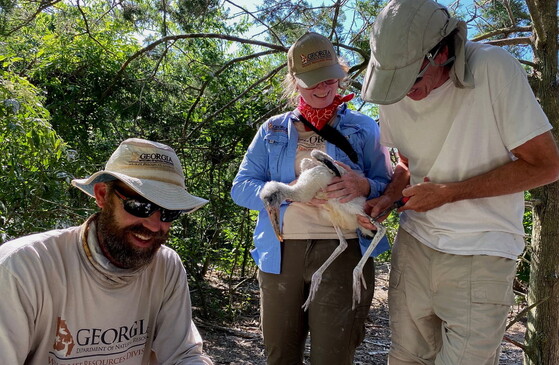 Banding a wood stork chick at Gilman rookery (DNR)
Quick hits:
- Staff with DNR’s Wildlife Conservation Section recently banded about 25 wood stork chicks at Gilman rookery near St. Mary’s, the largest private-lands colony in the state for America’s only true stork.
- National Fishing and Boating Week features two free-fishing days – Saturday, June 3 and 10 – when neither a fishing or trout license nor a lands pass (for public fishing and wildlife management areas) is needed.
- Get schooled on fire at the Georgia Prescribed Fire Council’s annual North Georgia meeting, set for June 22 in Jasper.
- The U.S. Postal Service has released 20 new Endangered Species Forever stamps, each depicting an imperiled species such as piping plover and Florida panther to commemorate the Endangered Species Act’s 50th anniversary.
- Monarchs Across Georgia’s Pollinators Symposium, scheduled June 24 in Winder, features speaker Anne Spafford, co-author of “Pollinator Gardening for the South.”
Names in the news: Two Georgians took home national honors in the 25th Wildlife Forever Fish Art Contest. Isabella Puzyreva of Cumming placed second in the K-third grade group and Minakshi Chilagani of Johns Creek finished third among fourth- through sixth-graders. These and other winners in the Georgia Fish Art Contest are listed at georgiawildlife.com. DNR plant ecologist Stephanie Koontz co-authored companion papers published in the journal Conservation Science and Practice – here’s one paper and the other – and highlighting conservation needs and considerations for Garrett’s mint, an endangered species found only in Florida. This work was done in her previous position with Archbold Biological Station.
"Georgia coast provides a critical refuge for this shorebird," The Current
"Statewide winners announced in Give Wildlife a Chance Poster Contest," Rockdale County Citizen and others. Also: "Athens students nab top spots in wildlife poster contest," Athens Banner-Herald
(+audio, video) "Wildlife enthusiast Cave shares Atlanta wildlife to look for this summer," WABE-FM (90.1, Atlanta)
"Head of Georgia DNR steps down to oversee Jekyll management," Georgia Recorder and others, including Atlanta Journal-Constitution
(+video) "What to know about Georgia's 47 snake species," WMAZ-TV (ch. 13, Macon)
"Environmental groups score reprieve for sea turtles as Army Corps backs off dredging plan," Georgia Recorder
"Partnering to stop songbird smuggling," U.S. Fish and Wildlife Service
"Underwater robot deployed to aid right whales off Georgia coast," WABE-FM (90.1, Atlanta)
"Do hungry North Atlantic right whales follow their noses?" Hakai
"Study looks at effects of lost fishing gear off Nova Scotia," CTV News
"Stewart Co. couple awarded $135.5M for property damage by solar company, contractor," WRBL-TV (ch. 3, Columbus)
"Why these 'redneck' lizards thrive in Georgia, S.C.," Georgia Public Broadcasting
"Providence Canyon State Park to expand," Georgia Public Broadcasting
"When your backyard becomes too wild," Morgan County Citizen and others
"Fla. lawmakers propose $1B in land conservation," WUSF-FM (ch. 89.7, Tampa)
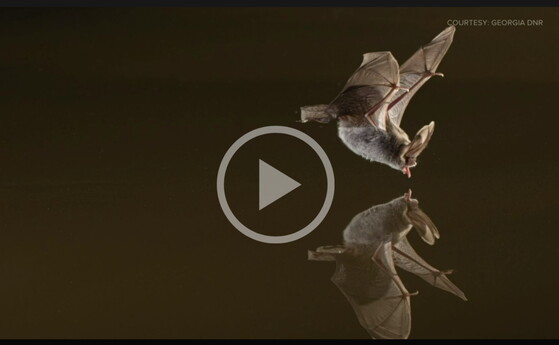 "Georgia DNR Counts Bats for Conservation," WMAZ-TV (ch. 13, Macon). Also: (audio) "Counting Bats in the Name of Science," Georgia Public Broadcasting.
"Eagle Seen 'Swimming,' Then Comes Another Surprise," Yahoo!news (via Miami Herald)
"Firearm Manufacturer Partnerships Drive American Conservation Funding," National Shooting Sports Foundation
(audio) "Everything Bog Turtles," Orianne Society Snake Talk podcast episode
"Wood Stork Tours Vacant Savannah Nest," Savannah Bird Cam
"Bear Survives Rapids in Swollen California River," Viral Hog (article)
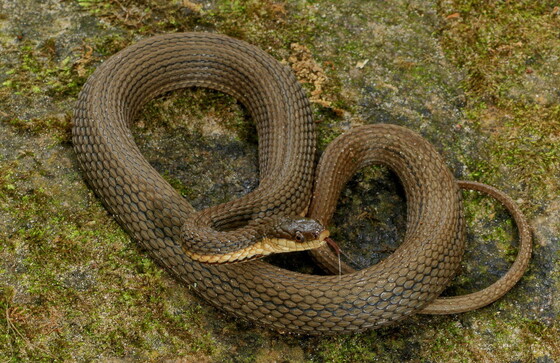 Queen snake (Alan Cressler)
If you have a taste for crawdads, you’re not the only one. Equipped with a slender frame and a keen sense of smell, queen snakes feast primarily on soft, newly molted crayfish in streams. Yet for these Georgia snakes, the predator/prey relationship is a delicate balance: Shelled crayfish can, in turn, prey on young queen snakes.
- Ethan Hatchett
CREDIT
Masthead: queen snake (Mark Krist)
Top
|